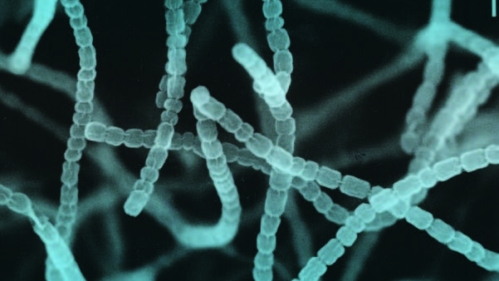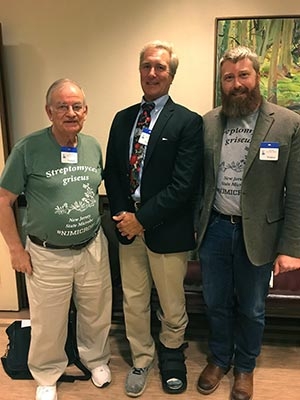In New Jersey we are proud of our state flower, the Common Meadow Violet (Viola sororia), and the state bird, the American Goldfinch (Spinus tristis). Microbes are a major component of our soil's ecology: Filamentous bacteria (Streptomyces) give the soil that wonderful earthy aroma (geosmin), they turn over organic materials to maintain soil fertility, and are also a major source of today's antibiotics. Yet, we lack a state microbe.
To date, only Oregon has recognized a state microbe: Saccharomyces cerevisiae, yeast, the basis of brewing, in recognition of the state's many small craft breweries. Wisconsin and Hawaii are considering naming state microbes as well. The microbe Streptomyces griseus, discovered in New Jersey, has dramatically advanced world health and thus merits state recognition.
Streptomycin was discovered by Albert Schatz, Elizabeth Bugie and Selman Waksman in January of 1944. It was truly remarkable in the breadth of pathogens that it attacked, including Vibrio cholerae (cholera) and Mycobacterium tuberculosis (TB), against both of which penicillin, the only other antibiotic at that time, had no effect. The discovery of streptomycin radically changed public health.
This producer of streptomycin (Streptomyces griseus), which was discovered in New Jersey soil and also isolated from the gullet of a healthy New Jersey chicken, was developed at the Department of Biochemistry and Microbiology, Rutgers, the State University of New Jersey, where its remarkable antibiotic properties were recognized. It was used in the development of large scale fermentation, a novel concept at that time. There had been war-time pressures to increase the production of penicillin via deep tank submerged fermentations. This was successful, evidenced by the general availability of penicillin on D-Day, June 6, 1944. The pressure for enhanced penicillin production continued. George Merck, in assessing needs for penicillin and those for the newly found streptomycin, overrode Merck's scientific board, which was focused only on penicillin, and committed extra funding for a major new project: the production of streptomycin.
Thus streptomycin joined penicillin in the development of the pharmaceutical industry in New Jersey. Within four years of the discovery of streptomycin in 1944, the initial yields in the milligram range were ramped up to 3,000 kilograms per month, a million-fold increase. This enabled animal and human trials by Drs. William Feldman and Corwin Hinshaw, at the Mayo Clinic in Rochester, MN.
Nominations for a New Jersey State Microbe were encouraged. Three nominations stood out:
- Azotobacter vinelandii, discovered by Jacob Lipman in 1903 in Vineland, NJ soil. This was the second free-living aerobic nitrogen-fixing bacterium (the initial study was by M. Beijerinck - Azotobacter chroococcum 1901).
- Thiobacillus thiooxidans (or the updated name, Acidithiobacillus), discovered by Jacob Jaffe and Selman Waksman in 1922 in acid mine waste and associated transformations from New Jersey.
- Streptomyces griseus, discovered by Schatz, Bugie and Waksman in New Jersey in 1944; produces streptomycin and is active toward gram-negative pathogens and the tubercule bacillus.
Streptomyces griseus clearly emerged as the winner. Its selection as the New Jersey State Microbe followed a vote by New Jersey microbiological groups, the contest having been held at several NJ locations.
In brief: Why this microbe?
Answer:
- It saves millions of lives.
- It has created jobs; the development of the pharmaceutical industry in the 1950s was based in NJ.
- It was recognized for its production of streptomycin and on which Selman Waksman was awarded Nobel Prize for Physiology or Medicine in 1952.
Streptomycin has been a major weapon in the war against bacterial infections, shortening and preventing illnesses, alleviating suffering and even averting premature death. Streptomyces griseus and the antibiotic it makes, streptomycin, was discovered in NJ at the dawn of the antibiotic era, has saved millions of lives, extended human life span, and has dramatically changed and improved the course of world health.
Please write to your NJ legislator in support of this nomination.
John Warhol, Max Häggblom and Doug Eveleigh
State Microbe Media Reports
- Meet the NJ Microbe on Simply Science
- WHYY interview with Max Häggblom and Jeff Boyd
- Bill Passes Both Houses!
- NJ Assembly passes bill to designate state microbe
- NJ Senate votes unanimously to designate state microbe
- NorthJersey.com: How Albert Schatz and Selman Waksman discovered Streptomycin
- NJ.com: Meet Streptomyces Griseus
- 94.5 WPST
- WNYC
- New Jersey Monthly
- Liberty Science Center Announces Support for State Microbe
- NJTV covers "Microbes Rule" at Liberty Science Center
- The Daily Targum
- Audio of NJ State Assembly hearing, Sept. 17, feat. John Warhol, Doug Eveleigh and Jeff Boyd.
- NPR, All Things Considered
- NJ 12 Interview with Dr. John Warhol
- KYW News Radio
- CBS New York
- (interview with Professors Jeff Boyd and Doug Eveleigh)
- NJ.com
- Philly Inquirer
- NJ Spotlight
- SEBS/NJAES Newsroom



